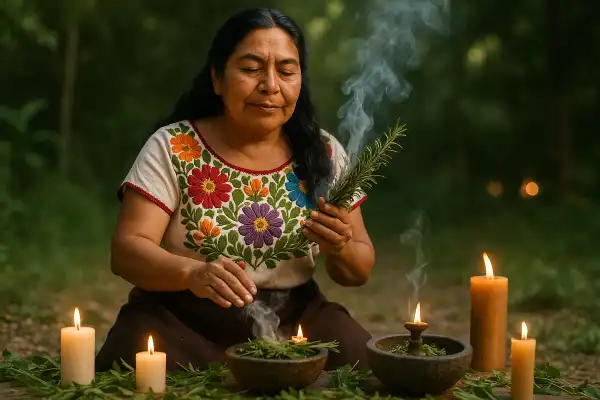Curanderismo ceremonies represent one of humanity’s most enduring approaches to healing, drawing seekers into sacred spaces where ancient wisdom meets contemporary needs. The increasing interest in these traditional Mexican healing rituals reflects a deep hunger for practices that honor the whole person – body, mind, and spirit – rather than treating symptoms in isolation.
María del Pilar Fernández, drawing from her lineage of curanderas in Oaxaca and her studies in cultural anthropology, believes these ceremonies offer profound medicine for our modern world. Through her work at RainyBlue.org, she seeks to share the transformative power of curanderismo ceremonies while honoring their sacred origins and cultural significance.
Curanderismo ceremonies
Curanderismo ceremonies are holistic healing rituals that have been practiced throughout Mexico and Central America for hundreds of years, serving as powerful tools for restoring balance and harmony to the body, mind, emotions, and spirit. These sacred practices represent far more than simple healing sessions; they are profound spiritual journeys that connect participants with ancestral wisdom, natural elements, and divine energies.

The foundation of curanderismo ceremonies rests on the understanding that true healing addresses multiple dimensions of human experience simultaneously. Physical healing involves the use of ritual objects, plática (heart-to-heart conversation), plants and herbs, song, and prayer, while spiritual healing employs prayer and meditation to communicate with spiritual beings such as Angels, Saints, Animal Protectors, and Deities for guidance and healing power.
Types of curanderismo ceremonies
Limpias (Spiritual Cleansings)
Limpias are Mexican spiritual cleansing rituals that cleanse body, emotions, mind, and soul from negative energies or thoughts, traditionally used to remove blockages and restore lightness, peace, and happiness. These ceremonies represent the most commonly performed rituals within curanderismo practice.
Different types of limpia ceremonies include fire rites for transformation, water rites for cleansing and influencing, and sweeping rites for divination. During these rituals, curanderas use various tools including herbs, flowers, eggs, feathers, copal incense, and sacred objects to remove stagnant energy and spiritual blockages.
The egg limpia stands as one of the most recognizable forms of this ceremony. During an egg cleanse, the curandera rolls an intact egg over the participant’s body from head to toe, then cracks it into a glass of water to reveal spiritual information about blockages or attachments. The patterns formed by the egg white and yolk serve as a diagnostic tool, revealing areas that require spiritual attention.
Temazcal Ceremonies
Temazcal is an ancestral shamanic ritual practiced by ancient civilizations throughout Central and North America, including the Maya, Aztecs, and Toltecs, designed for therapeutic healing to relieve stress, aches and injuries, cure skin or respiratory disease, and support spiritual purification.
The term temazcal comes from the Nahuatl language, meaning either “to bathe house” or “house of heat,” and traditionally consists of a dome-shaped structure representing the womb of Mother Earth. During ceremonies, participants enter a sweat lodge constructed from volcanic stone, wood, or cement, where hot volcanic rocks are placed in the center and water is poured over them to produce steam, often enhanced with herbs like sage or copal.
The ceremony lasts about two hours and takes place in several stages, with participants passing through four symbolic doors of life represented by the four elements, while the temperature increases gradually with the arrival of new hot stones. The temazcalero (spiritual guide) leads the ceremony with chants, sacred prayers, and music that honor nature, the elements, and ancestors.
Ceremonial elements and tools
Curanderismo ceremonies incorporate a rich array of sacred elements, each carrying specific energetic properties and symbolic meanings. Herbs such as sage, copal, and rosemary are commonly used, with each plant believed to possess unique energy and healing properties – chamomile for calming the mind and promoting relaxation, while sage serves for purification and spiritual cleansing.
Sacred objects play crucial roles in ceremonial practice. Crystals, candles, and feathers are believed to hold spiritual energy and amplify the cleansing effects of rituals, with crystals often placed around the body during ceremonies to absorb negative energy and promote healing. Prayer and intention form the spiritual foundation of all ceremonies, with practitioners setting positive intentions and invoking higher powers to amplify healing effects.
Healing applications and benefits
Curanderismo ceremonies work holistically to enable participants to release and cleanse limiting beliefs, traumas, and broken stories from the body, mind, and spirit, while healing acute and chronic conditions such as depression, insomnia, and anxiety. These practices address both visible ailments and subtle energetic imbalances that conventional medicine may not recognize.
The ceremonies prove particularly effective for treating susto (soul loss), often compared to PTSD in Western psychology. Curanderas increasingly focus on treating Susto/Espanto, addressing the effects of traumatic events such as sexual, physical, emotional, mental, and spiritual abuse, rape, death of loved ones, sexual trafficking, military service, divorce, or accidents.
Physical benefits often accompany spiritual healing. Temazcal ceremonies provide multiple health benefits including toxin elimination through sweating, improved circulation through heat-induced capillary dilation, skin purification through steam cleansing, and relief from water weight and bloating.
Cultural preservation and modern practice
Curanderismo represents a synthesis of Mexican indigenous culture and beliefs that has evolved through colonization, potentially incorporating Catholic, African, or other influences depending on the healer’s background, making it a blending of traditions rather than solely Native or European medicine. This adaptability has allowed the tradition to survive centuries of cultural challenges while maintaining its essential healing power.
Contemporary practitioners work to preserve these ancient ways while making them accessible to modern seekers. Teaching curanderismo allows students to reclaim traditions of New Mexico and Mexico that have existed for years, with many people’s grandmothers having known about traditional medicine and herbal healing practices that have since been lost.
The ceremonies continue to thrive in Mexican-American communities throughout the United States, where curanderas serve as cultural bridges, maintaining ancestral wisdom while adapting to contemporary needs. Universities now offer courses in curanderismo, recognizing its value as both cultural heritage and effective healing practice.
Disclaimer
Please note that Maria is not a physician, psychologist, or nurse. These culture-specific spiritual healing services are not meant to replace medical or psychological diagnosis and treatment. It is recommended that you see a licensed physician or licensed health care professional for any physical or psychological ailment you may have.
Recently, María del Pilar worked with Esperanza, a young woman from Guadalajara who sought help for persistent nightmares and anxiety following a difficult divorce. During their consultation, María del Pilar sensed that Esperanza carried the weight of her former husband’s negative emotions, which had become energetically attached to her spirit.
They began with a comprehensive limpia using white sage and rosemary, as María del Pilar gently swept the herbs around Esperanza’s body while offering prayers to the four directions. The ceremony revealed several areas of energetic blockage, particularly around her heart and solar plexus. Through sacred plática, Esperanza was able to express years of suppressed emotions and fears that had been affecting her sleep and daily life.
Following the limpia, María del Pilar prepared a special protection amulet containing blessed herbs and small crystals, which Esperanza wore close to her heart for thirty days. The combination of spiritual cleansing, emotional release, and ongoing energetic protection helped Esperanza reclaim her sense of personal power and peaceful sleep. Three months later, she reported feeling like herself again – clear, confident, and free from the anxious dreams that had plagued her for over a year.
